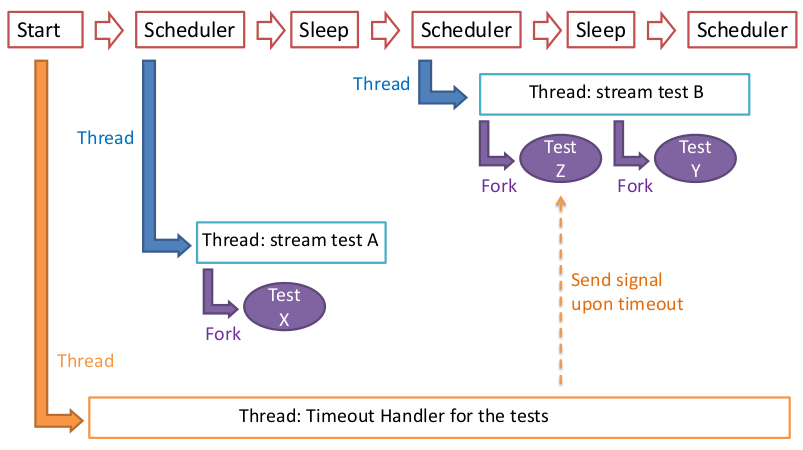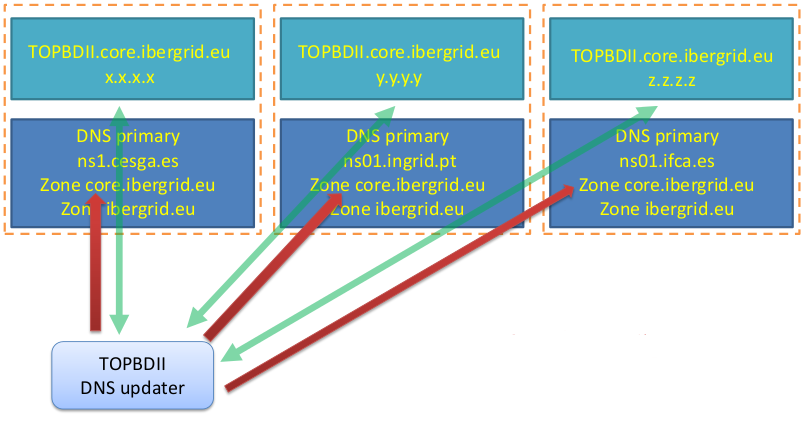MAN05 top and site BDII High Availability
Document control
| Property | Value |
|---|---|
| Title | MAN05 top and site BDII High Availability |
| Policy Group | Operations Management Board (OMB) |
| Document status | Approved |
| Procedure Statement | Deploying top or site BDII service in High Availability |
| Owner | SDIS team |
Top BDII and Site BDII with High Availability
This document objective is to provide guidelines to improve the availability of the information system, addressing three main areas:
- Requirements to deploy a top or site BDII service
- High Availability from a client perspective
- Configuration of a High Availability top or site BDII service
Requirements to deploy a top or site BDII service
Hardware
- dual core CPU
- 10GB of hard disk space
- 2-3 GB RAM. If you decide to set
BDII_RAM_DISK=yesin your YAIM configuration, it’s advisable to have 4GB of RAM.
Co-hosting
- Due to the critical nature of the information system with respect to the operation of the grid, the top or site BDII should be installed as a stand-alone service to ensure that problems with other services do not affect the BDII. In no circumstances should the BDII be co-hosted with a service which has the potential to generate a high load.
Physical vs Virtual Machines
- There is no clear vision on this topic. Some managers complain that there are performance issues related to deploying a top or site BDII service under a virtual machine. Others argue that such performance issues are related to the configuration of the service itself. The only agreed feature is that the management and disaster recovery of any service deployed under a virtual machine is more flexible and easier. This could be an important point to take into account considering the critical importance of the top or site BDII service.
Best practices from a client perspective for top BDII
- In gLite 3.2 and EMI you can set up redundancy of top BDIIs for the clients (WNs and UIs) setting up a list of top BDII instances to support the automatic failover in the GFAL clients. If the first Top level BDII fails to be contacted, the second will be used in its place, and so on. This mechanism is implemented defining the BDII_LIST YAIM variable according to the following syntax:
BDII_LIST=topbdii.domain.one:2170[,topbdii.domain.two:2170[...]].
- After running YAIM, the client enviroment should contain the following definition:
LCG_GFAL_INFOSYS=topbdii.domain.one:2170,topbdii.domain.two:2170
The data management tools (
lcg_utils) contact the information system for every operation (lcg-cr,lcg-cp, …). So, if you have your client properly configured with redundancy for the information system, thelcg_utilstools will use that mechanism in a transparent way. Be aware thatlcg-infositesdoesn’t work with multiple BDIIs. Onlygfal,lcg_utils,lcg-infoandglite-sd-query.Site administrators should configure their services with this failover mechanism where the first top BDII of the list should be the default top BDII provided by their NGI.
Best practices for a top or site BDII High Availability service
- The best practice proposal to provide a high availability site or top BDII service is based on two mechanisms working as main building blocks:
- DNS round robin load balancing
- A fault tolerance DNS Updater
We will provide a short introduction to some of these DNS mechanisms but for further information on specific implementations, please contact your DNS administrator.
DNS round robin load balancing
Load balancing is a technique to distribute workload evenly across two or more resources. A load balancing method, which does not necessarily require a dedicated software or hardware node, is called round robin DNS.
We can assume that all transactions (queries to top or site BDII generate the same resource load. For an effective load balancing, all top or site BDII instances should have the same hardware configurations. In other case, a load balancing arbiter is needed.
Simple round robin DNS load balancing is easy to deploy. Assuming that there is a primary DNS server (
dns.domain.tld) where the DNS load balancing will be implemented, one simply has to add multiple A records mapping the same hostname to multiple IP addresses under the core.top.domain DNS zone. It is equally applicable to site BDII.
# In dns.domain.tld: Add multiple A records mapping the same hostname to multiple IP addresses
Zone core.domain.tld
topbdii.core.domain.tld IN A x.x.x.x
topbdii.core.domain.tld IN A y.y.y.y
topbdii.core.domain.tld IN A z.z.z.z
The 3 records are always served as answer but the order of the records will rotate in each DNS query
This does NOT provide fault tolerance against problems in the top or site BDIIs themselves
- if one top or site BDII fails its DNS “A” record will still be served
- one in each three DNS queries will provide the failed top or site BDII first answer
Fault tolerance DNS Updater
- The DNS Updater is a mechanism (to be implemented by you) which tests the different top or site BDIIs and decides to remove or add DNS entries through DNS dynamic updates. The fault tolerance is implemented by dynamically nsupdate introduced in bind V8 offers the possibility of changing DNS records dynamically:
- The nsupdate tool connects to a bind server on port 53 (TCP or UDP) and can update zone records
- Updates are authorized based on keys
- Updates can only be performed on the DNS primary server
- In the DNS bind implementation, the entire zone is rewritten by the DNS server upon “stop” to reflect the changes. Therefore, the zone should not be managed manually; and the changes are kept in a zone journal file until a “stop” happens.
Implementation
- There are several alternatives to implement the DNS Updater:
- NAGIOS based tests
- a demonized service
- scripts running as crons
What to test: BDII metrics
- Status information about the BDII is available by querying the
o=infosysroot for theUpdateStatsobject. This entry contains a number of metrics relating to the latest update such as the time to update the database and the total number of entries. And example of such entry is shown below.
$ ldapsearch -x -h <TopBDII/siteBDII> -p 2170 -b "o=infosys"
(...)
dn: Hostname=localhost,o=infosys
objectClass: UpdateStats
Hostname: lxbra2510.cern.ch
FailedDeletes: 0
ModifiedEntries: 4950
DeletedEntries: 1318
UpdateTime: 150
FailedAdds: 603
FailedModifies: 0
TotalEntries: 52702
QueryTime: 8
NewEntries: 603
DBUpdateTime: 11
ReadTime: 0
PluginsTime: 4
ProvidersTime: 113
- More extensive information can be obtained (modifyTimestamp,createTimestamp)
adding the
+:
$ ldapsearch -x -h <TopBDII/siteBDII> -p 2170 -b "o=infosys" +
(...)
# localhost, infosys
dn: Hostname=localhost,o=infosys
structuralObjectClass: UpdateStats
entryUUID: 09bf40e0-7b23-4992-af55-fd74f036a454
creatorsName: o=infosys
createTimestamp: 20110612223435Z
entryCSN: 20110615120723.216201Z#000000#000#000000
modifiersName: o=infosys
modifyTimestamp: 20110615120723Z
entryDN: Hostname=localhost,o=infosys
subschemaSubentry: cn=Subschema
hasSubordinates: FALSE
- The following table shows the meaning of the most relevant metrics:
| Metric | Description |
|---|---|
| ModifiedEntries | The number of objects to modify |
| DeletedEntries | The number of objects to delete |
| UpdateTime | To total update time in seconds |
| FailedAdds | The number of add statements which failed |
| FailedModifies | The number of modify statements which failed |
| TotalEntries | The total number of entries in the database |
| QueryTime | The time taken to query the database |
| NewEntries | The number of new objects |
| DBUpdateTime | The time taken to update the database in seconds |
| ReadTime | The time taken to read the LDIF sources in seconds |
| PluginsTime | The time taken to run the plugins in seconds |
| ProvidersTime | The time taken to run the information providers in seconds |
Previous BDII metrics can be checked to take a decision regarding the reliability and availability of a top or site BDII instance.
More information is available in gLite-BDII_top Monitoring.
DNS caching
- DNS records obtained in queries are cached by the DNS servers (usually during 24 hours). Therefore to propagate DNS changes fast enough it is important to have very short TTL lifetimes.
- DNS has not been built to have very short TTL values and these may increase highly the number of queries and as result increase the load of the DNS server
- The TTL lifetime to be used will have to be tested.
- If the top BDII are only used by sites in the region and if queries are only from the DNS servers of these few sites then the number of queries may be low enough to allow for a very small TTL.
- This value should not be lower than 30s - 60s.
Example 1: The IGI Nagios based mechanism
In IGI, the DNS update of the number of instances participating in the DNS round robin mechanism depends on the results provided by a Nagios instance.
When Nagios needs to check the status of a service it will execute a plugin and pass information about what needs to be checked. The plugin verifies the operational state of the service and reports the results back to the Nagios daemon.
Nagios will process the results of the service check and take appropriate action as necessary (e.g. send notifications, run event handlers, etc).
Each instance is checked every 5 minutes. If a failure occurs, Nagios runs the event handler to restart the BDII service AND remove the instance from the DNS round robin set using
dnsupdate:
- an email is sent as notification;
- If 4 (out of 5) instances are failing, a SMS message is sent as notification;
- If a failed instance appears to be restored, Nagios will re-add it to the DNS round robin mechanism.

- This approach has some single points of failures:
- The Nagios instance can fail
- The master DNS where the DNS entries are updated can fail
Example 2: The IBERGRID scripting based mechanism
In IBERGRID, an application (developed by LIP) verifies the health of each top BDII. The application can connect to the DNS servers and remove the “A” records of top BDIIs that become unavailable (non responsive to tests).
The monitoring application (nsupdater) is a simple program that performs tests, and based on their result acts upon DNS entries
- Written in perl
- Can be run as daemon or at the command prompt
- The tests are programs that are forked
- Tests are added in a “module” fashion way
- Can be used to manage several DNS round robin scenarios
- Can manage multiple DNS servers

- To remove the DNS single point of failure as in previous example, one could configure all DNS servers serving the core.ibergrid.eu domain as primary
- Three primary servers would then exist for
core.ibergrid.eu - All three DNS servers could be dynamically updated independently
- The monitoring application should also have three instances, one running at each site
- The downside is that DNS information can become incoherent. It would be up to the monitoring application to manage the three DNS servers content and their coherence
